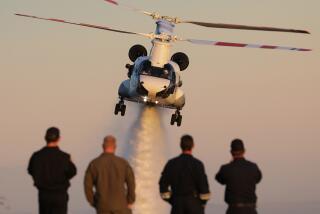Flight Limit Key to El Toro Plan Is Under Attack
- Share via
The plan to convert the El Toro Marine Corps Air Station to an international airport hinges on flight restrictions that some lawmakers are trying to abolish.
Efforts are afoot at the federal level to reduce or eliminate “perimeter rules,” which limit the distance that commercial flights can travel from certain airports. One such rule is a central element of the county’s airport plan for El Toro.
Under that plan, endorsed by Board of Supervisors last week, El Toro would handle all medium- and long-haul flights. John Wayne Airport would serve only short flights, such as shuttles to Las Vegas, Sacramento and the Bay Area. To achieve this balance, the county proposes that flights into and out of John Wayne be limited to those within a 500-mile radius.
But critics say such arrangements stifle competition and, in some cases, inflate ticket prices. The General Accounting Office recently recommended that Congress pass legislation eliminating perimeter rules to boost competition among airlines. And the restrictions are under fire at the three airports that currently use them: New York’s LaGuardia Airport, Ronald Reagan Washington National and Dallas’ Love Field.
“I don’t think [Orange County] can get a perimeter rule” given the political climate, said Mike Boyd, a Colorado airport consultant. “The problem people have with these rules is that they go against market forces. You’re basically having the government decide what kind of flights you have at which airport rather than letting the market decide.”
Sen. Richard C. Shelby (R-Ala.), chairman of the Senate Appropriations Subcommittee on Transportation, agreed the perimeter rules undermine competition among airlines and should be abandoned.
“To allow . . . [these] special federal air rules to stand is, without a doubt, wrong,” said Shelby, who has been trying to end the restrictions at Love Field. “It punishes the consumer, and it discourages job growth and economic prosperity.”
The perimeter rules were established at the three airports to divert some air traffic to other airports close by and to minimize noise for nearby residents.
Orange County officials want the restrictions to ensure that John Wayne stays in business after the much larger El Toro airport is completed. Without the separation of flights, officials fear, airlines won’t use John Wayne anymore. And that would run afoul of the supervisors’ mandate for a two-airport system so noise and traffic for neighbors of El Toro are moderated.
Preliminary county studies suggest that the number of passengers served by John Wayne Airport would drop by at least 20% if El Toro is built and the two airports operated in an unregulated environment. With John Wayne limited to short-haul flights, and all of the medium- and long-haul flights diverted to El Toro, the number of passengers flying in and out of John Wayne would still increase about 20% by 2020, officials said.
The plan also allows El Toro more international and cargo flights.
“The perimeter rule forces John Wayne to be a more significant contributor to two-airport system,” said Ron Ahlfedt, the county’s lead aviation consultant on the El Toro plan.
But the future of perimeter rules remains uncertain, especially as lawmakers and some consumer groups push for changes in New York, Washington and Dallas to make airlines there more competitive.
A General Accounting Office report attributed higher-than-average ticket prices at Reagan National Airport in part to perimeter rules and related government regulations.
That airport prohibits flights to destinations more than 1,275 miles from Washington. The rules were designed to channel transcontinental and international flights to nearby Dulles Airport, which has struggled to lure passengers.
A bill by Sen. John McCain (R-Ariz.) would allow longer flights from Reagan National, and he has talked about eliminating the regulations entirely. But residents around that airport fear his effort would worsen noise and traffic.
In Orange County, planners over the next year will conduct more detailed projections of demand and meet with airline representatives to measure their interest in the perimeter rule and other issues.
The county also will prepare environmental impact reports on the entire airport proposal endorsed by the board and on three other airport alternatives that planners unveiled this year. Supervisors are scheduled to take a final vote on the project in the fall of 1999.
If the board decides to seek the flight restrictions, officials have several options. One is to seek special legislation in Congress, as Dallas officials did to restrict flights at Love Field. The other is to seek Federal Aviation Administration approval. That would require a cost-benefits analysis and an air-safety study, and airlines would have a voice in the process.
Despite the criticism, county officials said their preliminary research suggests that a perimeter rule at John Wayne is feasible and is worth closer study. Michael Gatzke, the attorney representing the county on El Toro matters, noted that an appellate court ruling involving LaGuardia Airport clearly gives operators of “two-airport systems” like John Wayne and El Toro the right to seek restrictions.
“This issue has been litigated,” he said. “It’s the law.”
The Air Transport Assn., the industry’s leading trade group, has not taken a position on restrictions at John Wayne. But some airline executives have said they prefer having a single large airport in Orange County.
“The general trend is to avoid regulations . . . and [rely] on natural market forces,” county consultant Ahlfedt acknowledged. “So we expect [the airlines] to react cautiously.”
(BEGIN TEXT OF INFOBOX / INFOGRAPHIC)
Flying to the Edge
The El Toro airport plan endorsed by the Board of Supervisors would seek special restrictions at John Wayne Airport, limiting the distance of commercial flights to about 500 miles. Three U.S. airports now have similar regulations, known as “perimeter rules.”
Existing Perimeter Airports/Destination Limits
LaGuardia (New York): 1,500 miles
Reagan-National (Washington): 1,275 miles
Love Field (Dallas): Oklahoma, New Mexico, Arkansas, Louisiana, Kansas, Alabama, Mississippi
Perimeter Criticism
* Thwarts competition among airlines
* Results in higher ticket prices
Perimeter Support
* May result in less noise and traffic for neighbors
* Allows officials to balance flight demand between two airports instead of one gettingall traffic
Sources: Individual airports, Times reports
More to Read
Sign up for Essential California
The most important California stories and recommendations in your inbox every morning.
You may occasionally receive promotional content from the Los Angeles Times.











